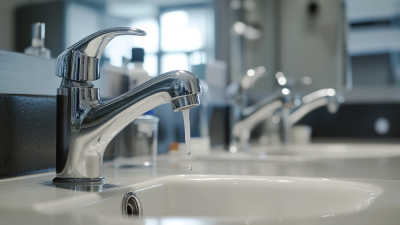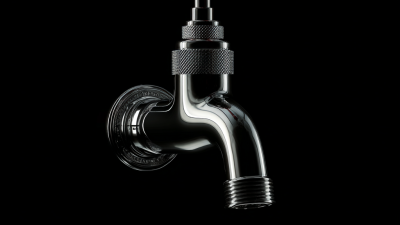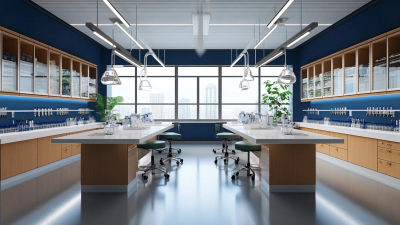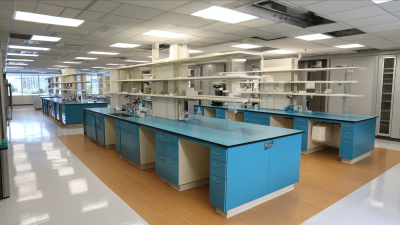As the 138th Canton Fair approaches in 2025, the spotlight is set on innovative lab faucet solutions that are poised to drive significant growth within the industry. With advancements in technology and a renewed focus on safety and efficiency in laboratory environments, manufacturers are unleashing cutting-edge designs that cater to the evolving needs of professionals. Lab faucets, often deemed the unsung heroes of laboratory functionality, are now being reimagined to enhance user experience through smart features, sustainable materials, and improved ergonomics. This year’s fair promises to showcase a variety of these innovative products, highlighting their role in supporting research and development across diverse scientific fields. The convergence of industry leaders and innovators at the Canton Fair creates an invaluable opportunity for networking, knowledge exchange, and fostering collaboration that will shape the future of laboratory equipment.

At the 138th Canton Fair 2025, innovative trends in lab faucet technology took center stage, capturing the attention of industry professionals and stakeholders alike. Cutting-edge designs focused on enhancing functionality and user experience. Manufacturers showcased faucets equipped with advanced features such as touch-free operation, customizable flow rates, and integrated filtration systems, aimed at ensuring superior hygiene and efficiency in laboratory environments.

Moreover, sustainability was a key theme. Many exhibitors highlighted eco-friendly materials and energy-saving technologies that reduce water consumption without compromising performance. These innovations not only align with global sustainability goals but also address the growing demand for environmentally responsible laboratory solutions. The integration of smart technology, such as IoT-enabled faucets, reflects the industry's shift towards intelligent laboratory environments, offering real-time data collection and improved operational management.
The Canton Fair served as a vibrant platform for these pioneering lab faucet solutions, driving the industry forward while setting a benchmark for future developments.
At the 138th Canton Fair 2025, innovative lab faucet solutions are taking center stage, showcasing their crucial role in enhancing industrial efficiency and sustainability. Recent studies indicate that laboratories consume approximately 50% more energy than standard commercial buildings, primarily due to outdated infrastructure. By implementing advanced lab faucets designed for optimal water usage and energy efficiency, facilities can significantly reduce their overall environmental impact. According to a report from the International Journal of Environmental Research, modernized laboratory systems can improve efficiency by up to 30%, leading to substantial savings in both operational costs and resource consumption.
Tip: When selecting lab faucet solutions, look for models designed with eco-friendly features, such as automatic shut-off valves and low-flow aerators. These technologies not only minimize water waste but also contribute to a greener laboratory environment.
Furthermore, integrating smart technologies into lab faucet designs offers real-time data monitoring, allowing facilities to track water usage and energy consumption more effectively. A report by the Laboratory Equipment Manufacturers Association highlights that such systems can increase operational efficiency by allowing for predictive maintenance and immediate adjustments to usage patterns. This predictive approach not only enhances sustainability but also supports long-term cost reduction strategies, demonstrating a clear connection between innovative lab faucet solutions and improved industrial performance.
Tip: Engage stakeholders in discussions about upgrading to smart lab faucets; the long-term benefits often outweigh initial costs, paving the way for a more sustainable future.
The 138th Canton Fair in 2025 is set to be a pivotal event for lab equipment manufacturers, particularly regarding innovative lab faucet solutions that are essential for modern laboratories. This fair will not only showcase cutting-edge technologies but will also serve as a significant networking platform for industry professionals. With increasing demands for laboratory efficiency and improved safety protocols, the networking opportunities available at the fair are expected to facilitate collaborations that drive advancements in laboratory equipment design and functionality.
Recent reports have highlighted the growing market for laboratory equipment, projected to reach USD 45 billion by 2027, with a compound annual growth rate (CAGR) of over 6%. Events like the Canton Fair provide a crucial venue for manufacturers to connect with key stakeholders, share ideas, and explore partnerships that can accelerate product development and market entry. Attendees will have the opportunity to interact with leading experts, explore the latest innovations, and discuss shared challenges in a rapidly evolving industry landscape, effectively positioning themselves for growth in an increasingly competitive market.

As the global demand for laboratory equipment continues to surge, the innovation of lab faucets is a key area driving market growth. According to a recent report by Research and Markets, the laboratory faucet market is projected to grow at a CAGR of 5.4% from 2025 to 2030. This growth is attributed to the increasing need for advanced laboratory facilities in pharmaceutical and biotechnology sectors. The 138th Canton Fair 2025 is set to showcase pioneering designs that not only enhance functionality but also prioritize safety and sustainability.
Innovative lab faucets are now being designed with smart technology, enabling remote monitoring and automatic shut-off features that help conserve water and reduce waste. A survey from Global Industry Analysts indicates that nearly 60% of laboratory managers are considering the adoption of eco-friendly equipment to align with sustainability goals. As these innovations enter the global market, they not only improve the efficiency of laboratory operations but also open up new avenues for companies to establish their presence in regions prioritizing green technology.
Tips: When selecting lab faucets, consider those equipped with features like automatic flow control and antimicrobial surfaces for enhanced hygiene. Additionally, staying informed about new technologies can provide a competitive edge, particularly in sectors that prioritize environmental responsibility. Always consult with industry experts to select the best solutions tailored to your laboratory's specific needs.
At the 138th Canton Fair 2025, several innovative lab faucet designs showcased transformative advancements in laboratory functionality. One notable case study involved a research institution that implemented a state-of-the-art faucet system featuring touchless activation and programmable temperature control. This design significantly reduced the risk of contamination while optimizing workflow efficiency. Researchers reported a notable decrease in time spent on setup and clean-up, thereby enhancing productivity during critical experiments.
Another successful implementation was observed in a pharmaceutical company's lab, where smart faucets with integrated sensors were installed. These faucets automatically adjust water flow and pressure based on the specific needs of various experiments, minimizing waste and maintaining a consistent output. The results were a marked improvement in resource management, enabling the facility to conduct more experiments without incurring additional costs. Such examples not only highlight the effectiveness of these new designs but also illustrate their potential to set new standards in laboratory environments.






